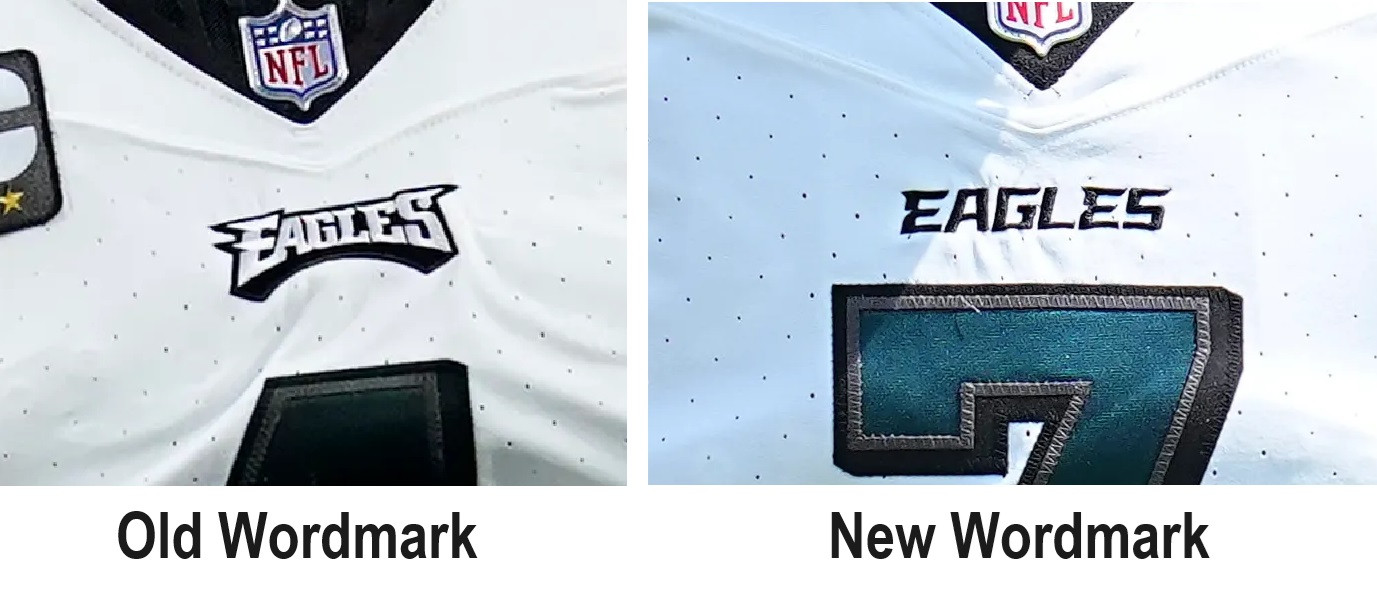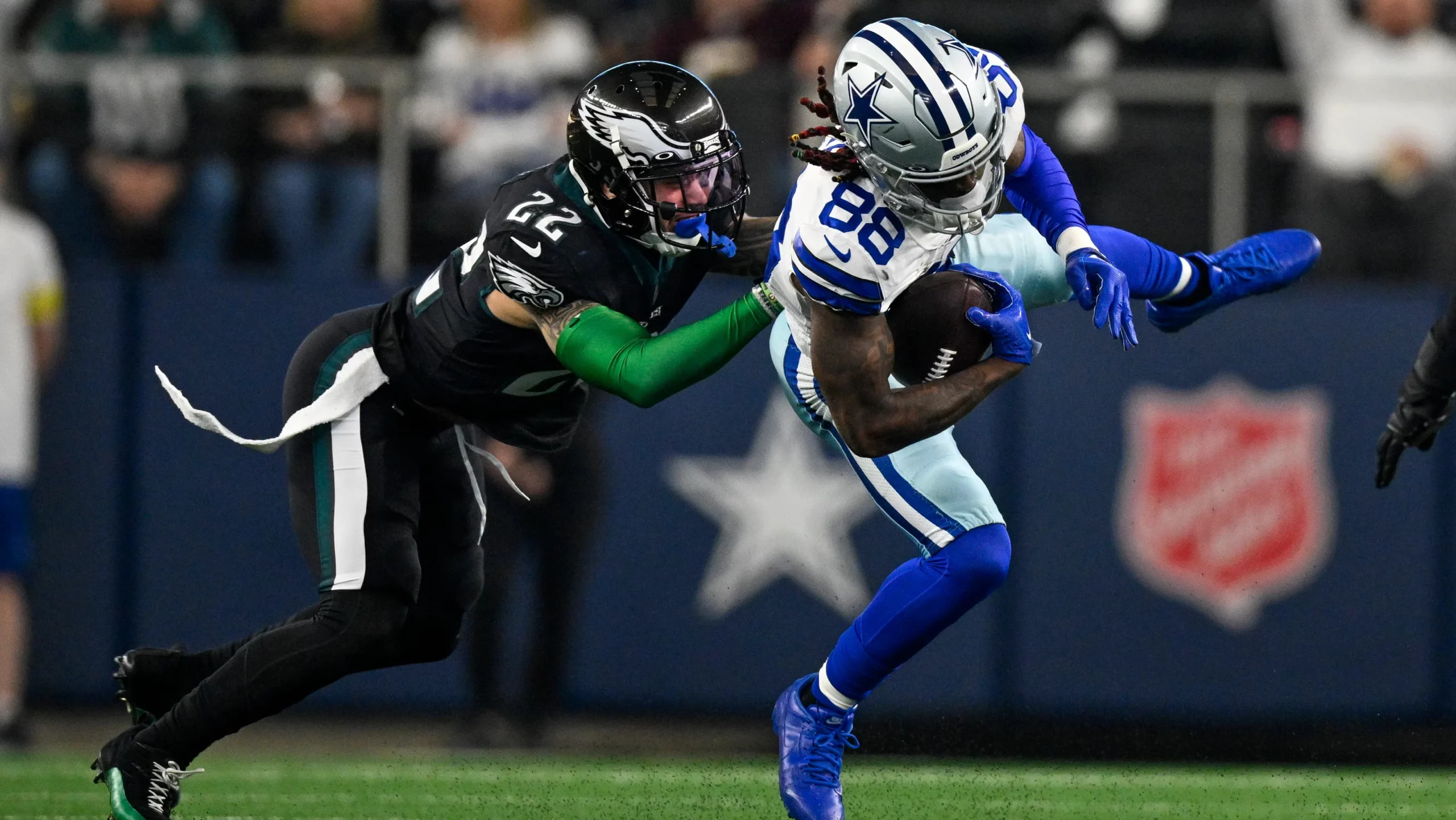In a move that’s generating buzz and a bit of head-scratching among NFL enthusiasts, the Philadelphia Eagles have announced they will don their striking all-black uniforms for their upcoming season finale against the New York Giants. This uniform selection, revealed just ahead of Sunday’s game, has sparked conversations, particularly concerning the league’s regulations on alternate uniforms.
Flip the Switch ⬛️@FanDuel | #FlyEaglesFly pic.twitter.com/NonaGWYXkq
The decision to bring out the Eagles Black Uniforms is surprising for several reasons, most notably because it potentially places the Eagles in a gray area regarding the NFL’s “alternate” uniform rule. This rule traditionally restricts teams to wearing throwback or alternate uniforms a maximum of three times during a season. While the Eagles have twice sported their popular kelly green throwback jerseys this season, they had yet to showcase their black jerseys until this announcement. At first glance, this might seem to comply with the rules.
However, a closer look reveals a potential complication. Earlier this season, in their international game in Brazil, the Eagles debuted a unique uniform combination: black helmets paired with white jerseys and black pants. The understanding has been that the use of an alternate helmet, regardless of the accompanying jersey and pants, counts as an “alternate” uniform appearance. If this interpretation holds true, then Sunday’s game in eagles black uniforms would mark their fourth instance of wearing an alternate uniform, seemingly exceeding the league’s seasonal limit.
This situation raises questions about how the Eagles are even permitted to utilize a third helmet design within the same season. Back in April, the NFL broadened its uniform policy, allowing teams undergoing a redesign process to introduce a third helmet option for the 2024 season, with this option becoming available to all teams in 2025. The updated policy states:
Teams going through a re-design process for the 2024 season have been offered a third helmet option, and it will be available for all teams for the 2025 season. The teams must inform the league office of their intent to utilize an alternate color helmet for the 2025 season by no later than May 1, 2024.
The second and third helmets, also known as “alternate color helmets,” can only be worn with one of the club’s authorized optional uniforms (classic, alternate and/or color rush). In addition, if either alternate color helmet is paired with a classic uniform, the helmet colors and designs must be historically compatible.
To the casual observer, it might appear that the Eagles are potentially bending two aspects of these conditions. Firstly, the allowance for a third helmet seems tied to a “re-design process.” Secondly, alternate color helmets are stipulated to be worn with “authorized optional uniforms.”
So, how did the Eagles manage to reintroduce their alternate black helmet into the rotation? The answer, surprisingly, lies in a minor, almost imperceptible change to their uniform this season. The Eagles subtly altered the small wordmark positioned above the jersey number and below the collar.

This seemingly insignificant tweak, detailed here, officially qualifies as a “uniform modification.” This minor wordmark update, which the Eagles had already incorporated into their endzones in 2022, took two years to finally appear on the jerseys. Despite the overall uniform remaining largely unchanged, this wordmark modification technically positions the Eagles as having “redesigned” their uniforms for the current season. This technicality allows them to utilize the third helmet option. However, it also subjects them to the “five-year rule,” which restricts further uniform alterations for five years, potentially delaying any hopes of the kelly green throwbacks becoming their primary uniforms.
While the “redesign” loophole seems to address the third helmet legality, the Brazil game uniform combination still presents a puzzle. In Brazil, the Eagles paired their black (alternate) helmets with white jerseys, seemingly contradicting the requirement that alternate helmets be paired with “authorized optional uniforms.” The question remains whether the Eagles received a special exemption from the alternate helmet rule for the International Series game. This exemption seems to be the most plausible explanation for how they could be permitted to wear what essentially amounts to a fourth alternate uniform.
You’ve NEVER seen this combo before@FanDuel | #FlyEaglesFly pic.twitter.com/LUf7ZH2JdU
It’s worth noting that some teams have navigated these uniform rules with creative interpretations in recent seasons. The Dallas Cowboys, for instance, technically created two distinct white alternate helmets—one for 1960s throwbacks and another for their all-white “color rush” uniform. However, as they used the same helmet shell color, it was deemed permissible. Similarly, the Carolina Panthers have paired their alternate black helmets with their black jerseys (also their primary dark jerseys), arguing that the all-black ensemble is their “color rush” uniform to remain within the rules. The Cincinnati Bengals employed a similar strategy, pairing their new white Bengal helmet with their white primary road jersey, designating the all-white look as an alternate, possibly even a “color rush” uniform.
TURN US UP.
It’s Kelly Green Week! pic.twitter.com/7y0wDacGX6
IT’S TIIIIIIMMMMEEE
🎨: @elijah5pittman | #FlyEaglesFly pic.twitter.com/baoMGErGPj
However, even with these creative interpretations, those teams still adhered to the three-alternate-uniform limit. Having already worn black helmets in Brazil and their kelly green throwbacks twice, the Eagles appeared to have reached their limit. The all-black uniforms would seemingly constitute a fourth alternate appearance.
The NFL has shown it takes these uniform rules seriously. Earlier this season, the San Francisco 49ers, facing extreme heat in Santa Clara, requested permission to wear their all-white throwbacks in a game where they were scheduled to wear their primary red and gold uniforms. Despite the heat concerns, the NFL denied their request to wear the white throwbacks but allowed them to wear their red throwback jerseys. The 49ers had initially planned to wear their red throwbacks later in the season but were required to switch to their regular uniforms to avoid exceeding the three-alternate limit. This strict enforcement against the 49ers further emphasizes the question of how the Eagles are seemingly permitted to wear a fourth alternate.
The most logical explanation, and one that aligns with the available information, is that the Eagles were granted an exemption for the Brazil game. This entire situation began when the NFL scheduled two teams with green as a primary color to play in São Paulo, a stadium where green is traditionally avoided due to rivalries. The Eagles, designated as the home team, arguably circumvented a color clash by wearing black helmets, white jerseys, and black pants, minimizing the presence of green. It is plausible that in allowing this solution, the NFL also granted the Eagles an exemption to the three-times-max alternate rule, essentially greenlighting (pun intended) their uniform choice for the Brazil game.
Assuming the eagles all-black uniforms are indeed within the league’s regulations, this game against the Giants will mark the fourth occasion the team has worn the all black uniforms and black helmets combination. Prior to the one-helmet rule being relaxed, the Eagles paired these black uniforms with their midnight green helmets. The three previous outings in the eagles black uniforms all occurred in the 2022 season. Let’s revisit their performance in these games.
The Eagles first debuted the all-black uniform on November 27, 2022, against the Green Bay Packers, securing a victory with a score of 40-33.
Their next appearance in the black uniforms was on Christmas Eve of 2022 against the Dallas Cowboys, resulting in a narrow 40-34 loss.

The last time they sported this combination was in their 2022 season finale on January 8, 2023, where they defeated the New York Giants 22-16.
With a 2-1 record in their all-black alternates and facing the struggling Giants, it might seem likely that the Eagles will improve to 3-1 in these uniforms. However, as NFC East champions with a 13-3 record, and already locked into the #2 seed for the playoffs, the stakes are relatively low for the Eagles in this game. With little on the line besides potentially Saquon Barkley chasing rushing records, the Eagles may opt to rest their starters for a significant portion of the game. While wins and losses are rarely attributed to uniform choices, the decision to wear their eagles black uniforms for the final game of the season remains an intriguing one.
In conclusion, the Eagles’ choice to wear their black uniforms against the Giants has opened up a fascinating discussion about NFL uniform regulations, potential loopholes, and possible exemptions. While the on-field impact of the uniform is debatable, the off-field conversation highlights the complexities and sometimes ambiguous nature of league rules, even when it comes to something as seemingly straightforward as game-day attire.
